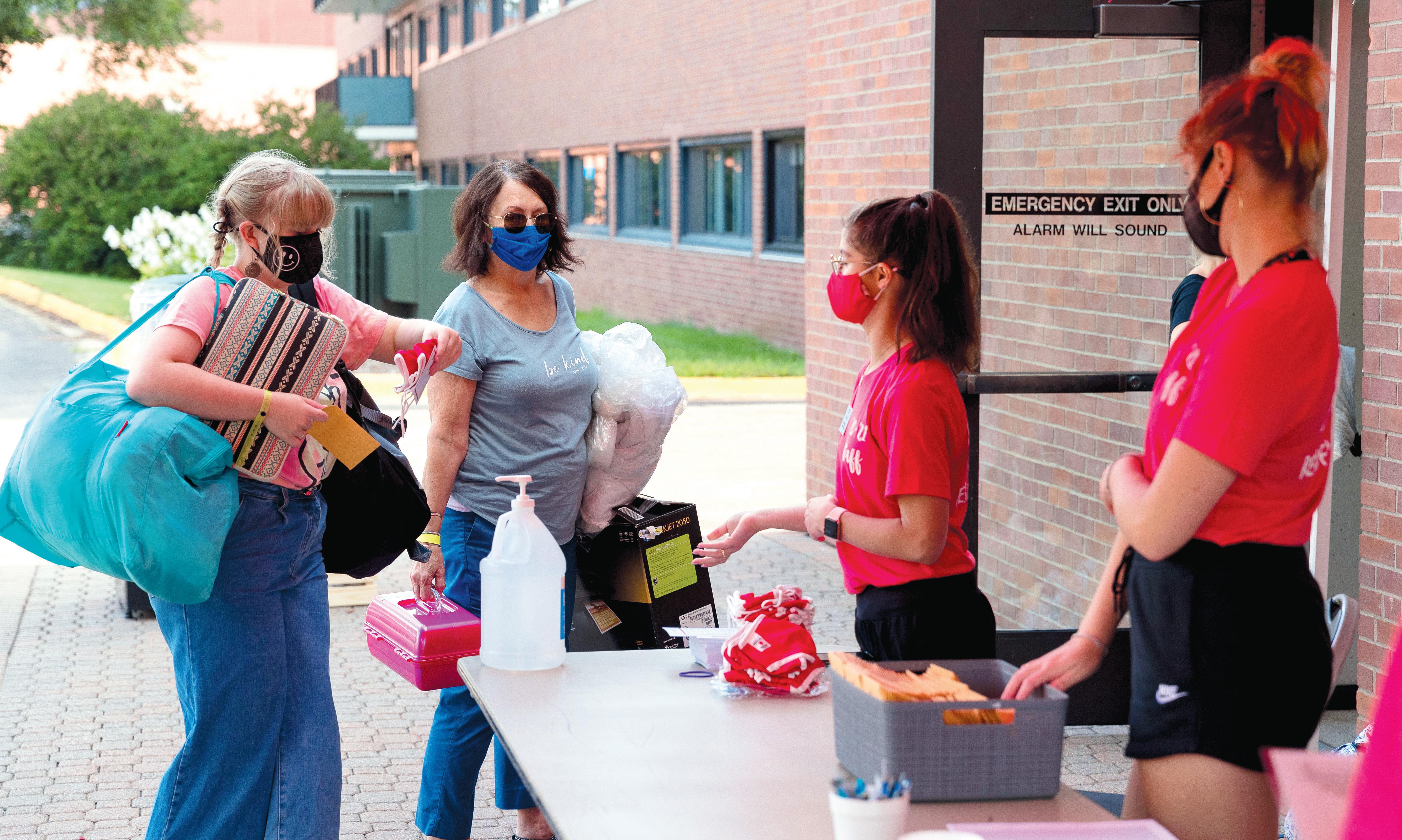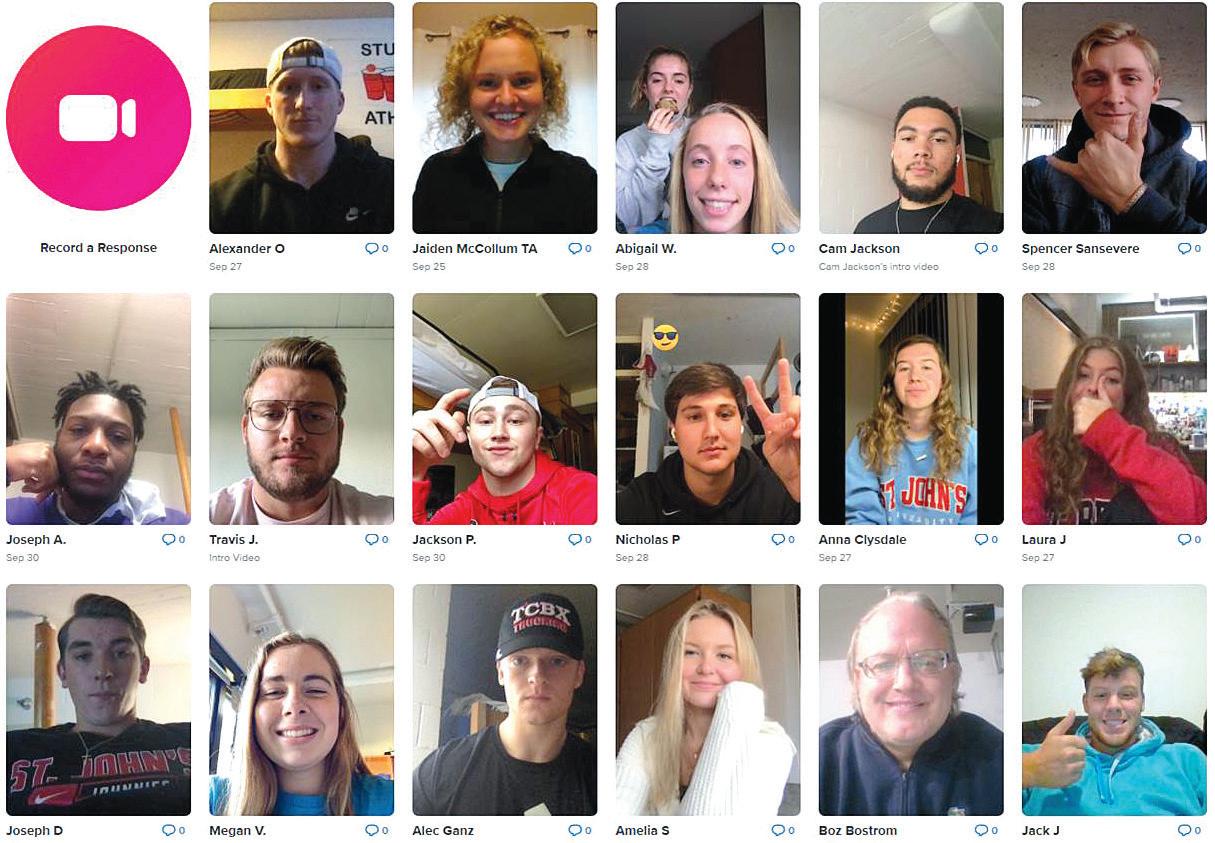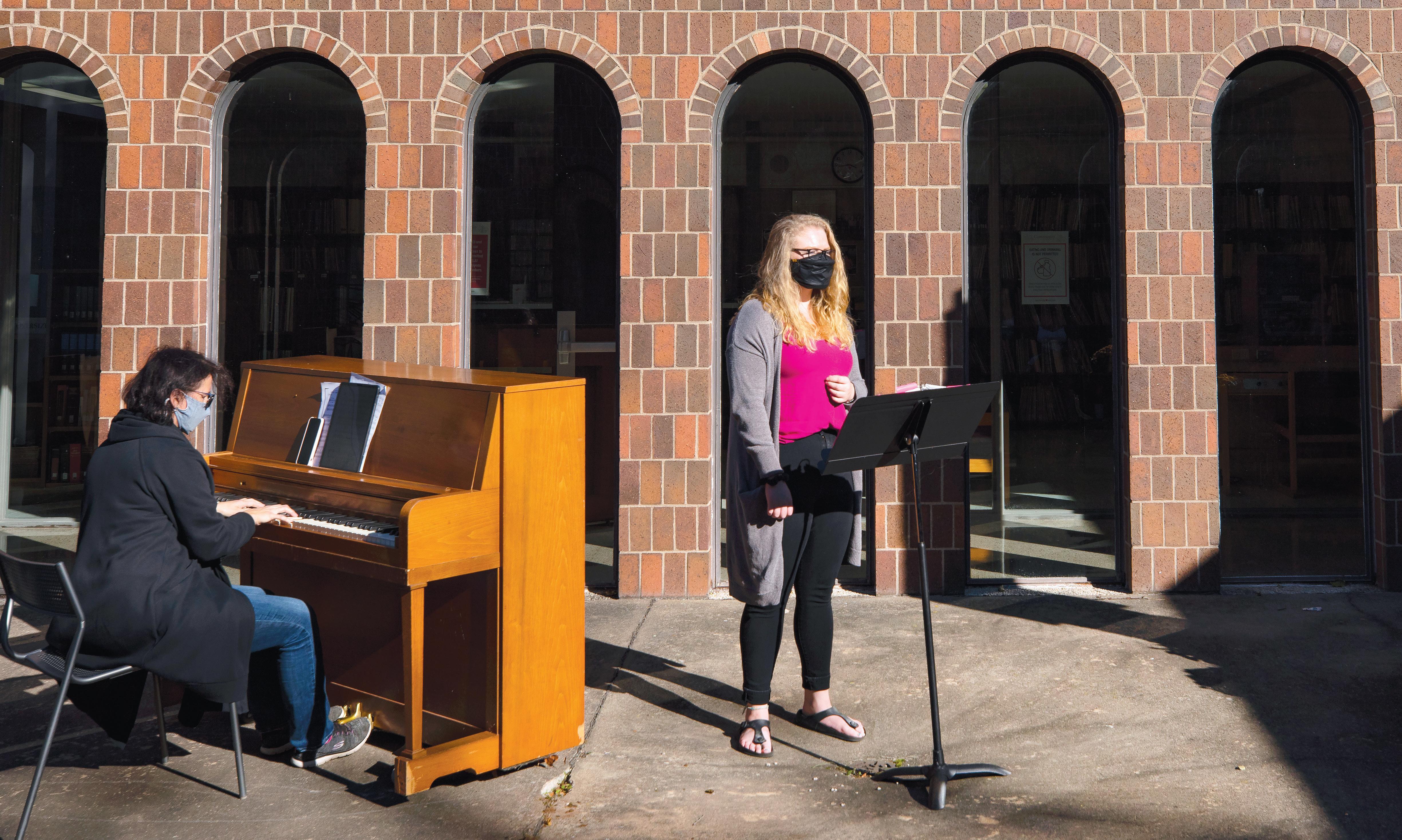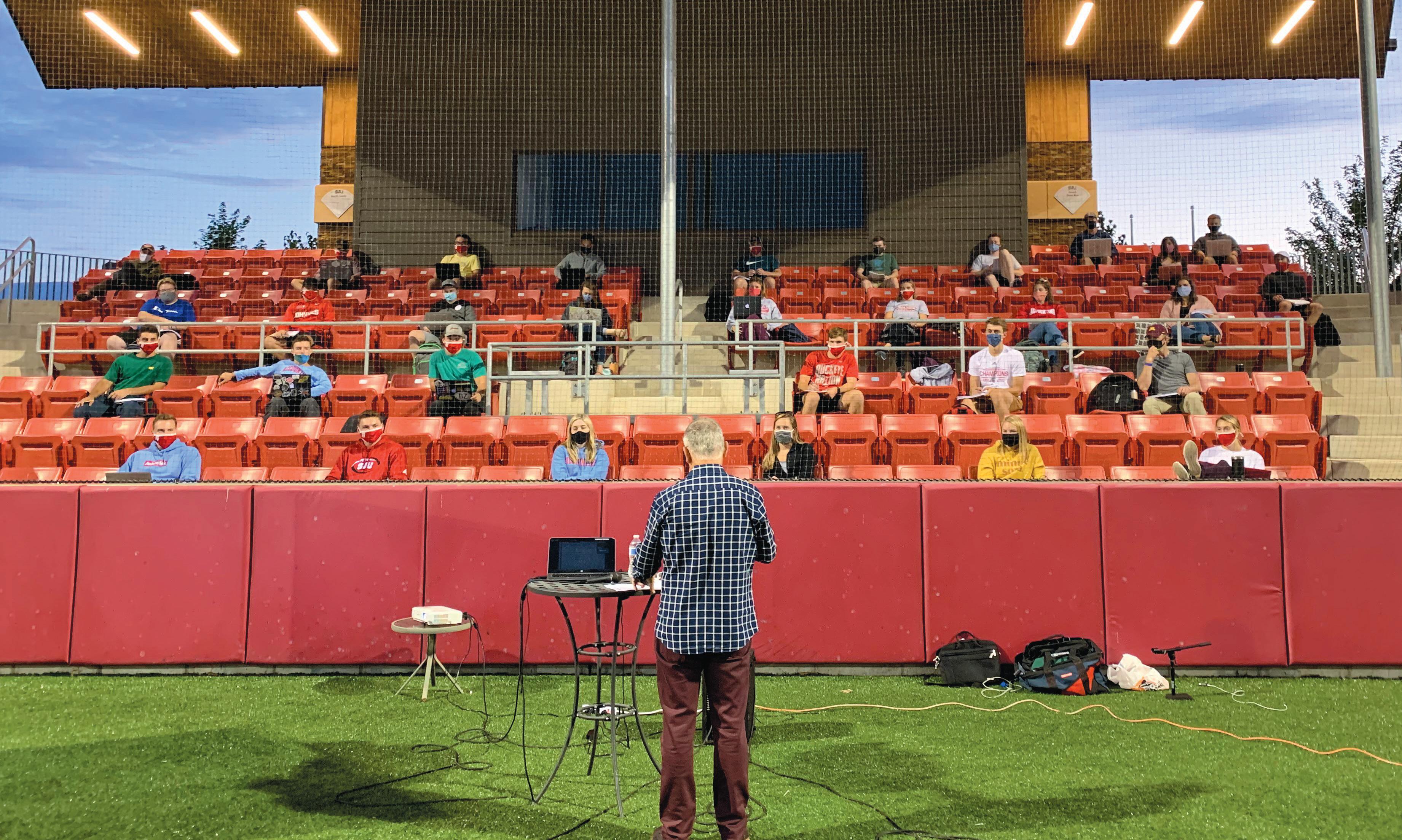
12 minute read
Strange Stories of Success
By the time you receive this magazine, the College of Saint Benedict and Saint John’s University will have just concluded one of the most unusual semesters in the history of either institution. The ongoing impact of the COVID-19 pandemic necessitated some odd and sometimes awkward changes and restrictions in nearly every facet of campus life. There were challenges, frustrations, disappointments and missed opportunities, to be sure.
But, in the midst of all the weird, as we sift through the rubble of what went on, it turns out there just might be some gems worth polishing. We’ve found some successes worth carrying forward when all is said and done.
Advertisement
Stretched-out move-in
First-year move-in day at Saint Ben’s is traditionally chaotic as nearly all first-year students roll in on a single day. It’s exciting and energetic and nearly everyone looks forward to it. It wasn’t broken, so no one really thought about fixing it.
This year though, things needed to be spread out. First-year movein was stretched out to cover not just Thursday but also Friday morning. All students were assigned a three-hour block of time for their arrival and move-in and were directed to their residence hall’s check-in zone. “We assigned students their times based on geographic locations in the buildings, managing elevator use and also making sure that sisters were moving in at roughly the same time,” says Christy Brown, director of residential life and housing.
Check-in zones were located outdoors to eliminate bottlenecks – which they did with great success. And, as the days went on, students, families and even staff all commented frequently that they preferred having a more scheduled, longer move-in process. “I don’t know if any of us were expecting that,” says Brown, “but we were glad to hear it. And it is certainly something we’re considering for future move ins.”
Reoriented orientation
Traditionally, Orientation Weekend for first-year students goes on from the moment they arrive on move-in Thursday through the end of the weekend. CSB and SJU pride ourselves on our sense of community, but … it’s a lot.
This year, with a goal of reducing face-to-face time with large groups, the Student Activities team created a website using Canvas, our learning management system. “It wasn’t meant to take the place of in-person orientation, but it allowed us to deliver a lot of that content in a different way,” explains Lacey Solheid, associate director of programming and orientation. “We could never replace the treasured in-person experience of orientation. But using Canvas lets those students get the content on a platform they’ll be using for their classes. So they are already exposed to Canvas by the time they get to class.”
Knock, knock
English Department instructor John Kendall sees an upside in this year’s proliferation of video meetings. “I’ve found that meeting with students individually is actually easier,” he says. “Now, that’s not to say I’d rather meet via Zoom – in person is ALWAYS best. However, when students have a writing question or an advising question, they actually don’t have to get out of their chair to ask – they can jump into my virtual office hours. Zoom knocks on my door for them. When the wackiness is over, I’ll continue to offer the Zoom virtual office hours as an alternative to physically coming to my office.”
Associate Professor Alicia Peterson, chair of the Chemistry Department, agrees. “Having all these meetings virtually has helped reduce barriers to access,” she observes. Beyond that, she’s seen advantages for faculty. “Having department and campus committee meetings virtual has allowed more people to attend who previously were not able to.”
Live and learn

None of us have ever navigated a pandemic like this before. So accounting professor Boz Bostrom (SJU ’95) gets a pass for an early misstep in Block A. For the next blocks – and moving forward into spring semester – he’s come up with a better way. Kicking off Block B, Boz posted on Facebook:
“My goal isn’t to be perfect the first time out, or really anytime out for that matter. Rather, I just try to get a little better each time. In A block, I went to have students introduce themselves on Day 1, which due to masks and social distancing turned out to be one of the dumber ideas I have had. So, for the new batch of students in B block, I used a private Flip Grid page to have them post a mask-free welcome video. I had the TAs also post a welcome video so that the students know who else they can reach out to. I will then watch these videos several times between each class, and should have all 33 of their names down within a couple days.”
Holding courtyard

“Many of our buildings were built in an era when courtyards were a big part of design,” notes Ryan Gideon, executive director of facilities. “But, for years, they have gone largely unused other than for a visual break if you were in a space overlooking one. With COVID, these courtyards have provided us a means for faculty to lead classes in open air. We created plans a year ago to enhance some of these courtyards and draw people in. COVID has been a spark for making that happen.”
Patricia Kent, assistant professor of voice in the CSB/SJU Music Department, has been making use of one of the courtyards in the Benedicta Arts Center (BAC). “These open spaces give students another way to connect with the outdoors and I’m so grateful we were able to utilize them this fall to give voice students an opportunity to sing for each other and to have face-to-face lessons. At our first outdoor studio class, the students commented how much fun it was to see and perform for each other, even with masks!”
“We have construction plans in place to add improvements to the north BAC patio, including decorative lighting and ability to charge electronic devices,” says Gideon. “Mary Commons courtyard was used a lot this fall for lunches and social gatherings. We installed a gas fire pit to extend its use later into the year.”
Virtual rock stars
This fall, in an effort to deliver safe and socially distanced leadership development training for student leaders, the Student Activities team hired speaker and musician Jason LeVasseur of the Rock Star Project to hold five weekly virtual training sessions.
“Personally, I feel like virtual events are looked down upon by lots of people,” says Lacey Solheid, associate director of programming and orientation. “But I don’t think people should be so quick to write it off. I have been able to see some incredible engagement by our students with the presenters and their fellow students during the presentations. I think we will definitely be looking at how we can use and leverage technology to deliver highquality content to our students. We definitely won’t be doing everything online, but we have had some really great successes.”
Hitting it out of the park

Sometimes this semester, it’s been less about “ideas we’ll carry forward” and more about “opportunities to stretch our ‘think differently’ muscles”. Early in the semester, accounting professor Boz Bostrom (SJU ’95) posted on Facebook:
“I’ve teamed up with Johnnie alums Scott Becker (SJU ’77) and Cary Musech (SJU ’80) in teaching a course on Private Equity. Had COVID not hit, tonight’s class would have been held in a typical classroom. But due to COVID and social distancing limitations, only about half the students could have attended in person and the rest would have watched online. So, we hauled out my PA system, projector, screen, tables, etc. and held the class at the Saint John’s baseball stadium, and it was perfect. Tonight, we won.”
COVID crucible?
“I might be an outlier in my thoughts on teaching in the block format, but I found some things to celebrate,” says Roy Ketchum, associate professor of Hispanic studies and Latino/Latin American studies. “Because of the pace, we had to dive right in, and students responded well. By the second day, they had warmed up to each other and were already willing to take some risks and be vulnerable with the learning process. I felt like students were generally more present in the classroom and more engaged listeners – particularly to each other.
“Using the hybrid technology may have had something to do with that. Out of necessity, we became comfortable with pausing, asking people to repeat, adjust the volume or step into the mic or camera. I think the little bit of extra effort we often had to make demonstrated that each voice was valued, whether it was coming from down on the floor (in the classroom) or from up in the cloud (connected remotely).
“I also found that students collaborated well both in the classroom and in projects that I assigned for them to complete on their own. I think the intensity of the experience helped cultivate a genuine feeling of community. In a group where half the students were first-years and this was their first college experience, that was important. On our closing day, I offered an opportunity for them to share some words of gratitude and hope for each other. All the way around the circle (COVID appropriate, of course), they were eager to stay in touch and keep looking out for each other. It had something to do with what they had shared together in relation to the course content (a new Culture and Social Differences course) but I think it also had a great deal to do with the intensity of being and learning together in the block format.”
A truly global classroom
Kingshuk Mukherjee, associate professor of global business leadership, has taught his Operations and Supply Chain Management class since 2008. This semester he was able to give it a positive new twist.
This semester, the four-credit class partnered 30 CSB/SJU undergrads with 11 master’s students from Thakur Global Business School in Mumbai, India, via Zoom. Students participated in online classes and projects together.
“This is the first time we have partnered virtually with our partner in Mumbai (Thakur Institute of Management Studies and Research, of which Thakur Global Business School is a part) to have a student-to-student exchange,” says Mukherjee. “We have professors from both institutes involved as co-coordinators, along with departmental and institutional support.”
Studying supply chain management with input from international voices makes perfect sense to Elena Branca ’21, from Plymouth, Minnesota. “This is the epitome of what our global business leadership major is trying to prepare us for,” she says. “Our world is dependent on a diverse set of strong business leaders from all over. We work better together.”
“We are all virtually connected now,” explains Mukherjee. “This ‘global classroom’ will be a new trend for higher education. The hyflex technology, along with the cameras in the classroom, gives an added effect of being in a real class with a global group of students.”
Learning to adapt

“I definitely picked the interesting year to be an RA,” observes Stephanie Honnold ’22. “I think the hardest thing about being an RA in COVID times is making those connections with my residents – whether by Zoom or meeting in person while social distancing. Learning to adapt to change quickly has been one of the most important things I have learned this year.”
The global business leadership major from Minnetrista, Minnesota, is crystal clear in her personal priorities and what she stresses for her residents: “I am here to get my education on campus. All the restrictions are straightforward and, if the restrictions are what keeps us on campus, then I’m going to follow them. Many of us have been affected by COVID-19 in some form – whether having the virus ourselves or knowing a loved one who’s had it – so we know the importance of keeping each other safe.”
Creating Connections
Gina Honek ’19 is the residence director for Regina Hall. And one of the most common things she heard from her residents early this fall was, “I want to meet new people.”
Most years, orientation groups are constructed drawing from across the first-year residence halls. “This year, orientation groups tended to be made up of people that lived on the same floor,” Honek explains. “And that made perfect sense. But it limited connections across halls.”
So Honek developed Creating Connections. “The premise is simple,” she says. “I send out a link that asks about interests and three words they would use to describe themselves. After a certain deadline, I gather the data and start matching students.”
Matches meet up for a meal or a movie or an activity –all based on their shared interests.
In just the first block, Creating Connections paired up around 20 individual students and another 15 sets of roommate pairs – so roughly 50 students. “I find it powerful when bright, young college minds are able to unite over new experiences and interests and exchange meaningful dialogue,” Honek concludes.





